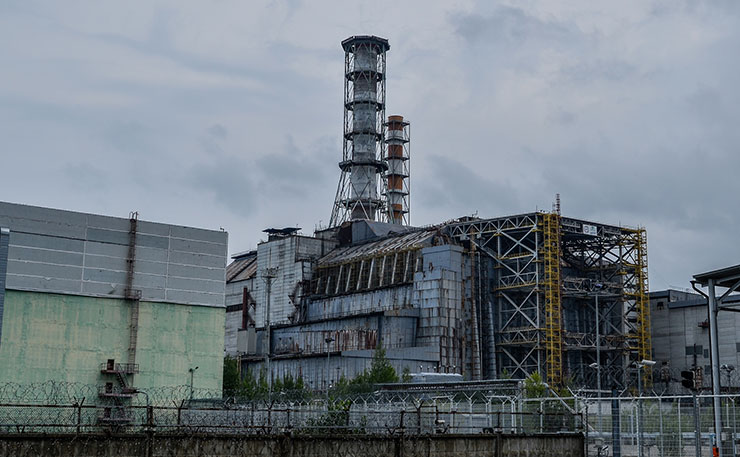We’re going to be sending uranium to the Ukraine. What could possibly go wrong, writes Dave Sweeney.
Earlier this week without fanfare, a group of federal politicians gathered to take a very quick look at an issue with very long consequences. As far as ideas go, a uranium sales deal between the country that fuelled Fukushima and the one that gave the world Chernobyl doesn’t sound like a good one.
And it’s not. There are serious and unresolved nuclear security, safety and governance concerns with the plan and putting more unstable nuclear material into a deeply politically unstable part of the world is force-feeding risk.
There is a lack of detailed information to support the safety and safeguards assumptions underpinning the proposed treaty action, and DFAT’s National Interest Analysis of the plan is deeply deficient, especially in relation to key safeguards and security concerns and the implications of the Russian conflict.
The NIA’s under-stated noting ‘that political tensions currently exist between Ukraine and Russia’ completely fails to recognise or reflect the gravity of the situation.
Thirty years ago this year, the Chernobyl nuclear disaster spread fallout over large swathes of eastern and western Europe and five million people still live in contaminated areas in Belarus, Ukraine and Russia.
Serious containment and waste management issues remain at Chernobyl with a massive concrete shield now under construction in an attempt to enclose the stricken reactor complex and reduce the chances of further radioactive releases.
Against this backdrop there are deep concerns over those parts of the Ukrainian nuclear sector that are not yet infamous names, including very real security concerns about nuclear facilities being targeted in the current conflict with Russia.
The Zaporizhia nuclear facility is Europe’s largest and is only 200 kilometres from the conflict zone in eastern Ukraine. Some commentators have described nuclear plants in the region as pre-deployed nuclear targets, and there have already been armed incursions during the recent conflict period.
This threat is more than a theoretical possibility. In mid-September 2016 a Times report documented concerns over high level Russian plans to destabilise the Zaporizhia administrative region (LINK) ‘Vladimir Putin ordered plot to seize half of Ukraine’, Australian, 15 September). Earlier acts of apparent sabotage have already seen the dangerous practise of emergency power unloading at nuclear power plants in Ukraine– including the Zaporozhskaya and South Ukrainian reactors.
Australia has already suspended uranium sales to Russia and it makes scant political or security sense to start selling uranium to Ukraine now. Along with security concerns there are serious and unresolved safety and governance issues with the proposed sales plan.
Ukraine has 15 nuclear reactors – four are currently running beyond their design lifetime while a further six will reach this in 2020. That means two thirds of Ukraine’s nuclear reactors will be past their use-by date within five years. The current deeply contested series of license renewals and the related European Bank for Reconstruction and Development (EBRD) financing of a program to upgrade safety features at Ukrainian nuclear facilities has highlighted serious deficiencies in governance, operations and compliance with contemporary international standards.
On top of that, there is growing regional concern over the risks associated with the Poroshenko administration focus on keeping the reactors running. In rushing to extend operating licences Ukraine is cutting process and safety corners and not complying with its obligations under the Espoo Convention – an international framework agreement around transboundary environmental impact assessment. In April 2013 the UN Espoo monitoring group found that license renewals at the Rivne nuclear facility were not compliant with Espoo procedures.
In 2013 the Eastern Partnership, a leading East European civil society forum, declared that the absence of environmental impact assessment for nuclear projects posed “a severe threat to people both in Ukraine and in neighbouring states, including EU member states”. Nearby nations including the governments or Slovakia, Romania and Hungary have formally and unsuccessfully called for Ukraine to provide further detail on its nuclear projects and to facilitate increased regional dialogue on this unresolved issue of concern.
These concerns have been amplified after a series of recent shutdowns, fires and safety concerns at Ukrainian nuclear facilities.
The Ukrainian government’s response to continuing domestic and international disquiet over the operations of its nuclear sector was a 2015 government decree preventing the national nuclear energy regulator from carrying out facility inspections on its own initiative. This coupled with increased pressure on industry whistle-blowers and critics has done nothing to address the real risks facing the nations aging nuclear fleet.
None of these issues have been meaningfully identified, let alone addressed, in the treaty action or analysis to date. Any plan to supply Australian uranium to such a fraught region deserves the highest level of scrutiny. Instead, we have tick-a-box paperwork and cut-and-paste assurances.
The short inquiry into proposed sales deal was overshadowed this week by renewed safety concerns at the Fukushima nuclear plant in Japan following the recent earthquake and tsunami alert. Apart from any other reason, the Ukraine sales deal should not be advanced in the continued absence of any meaningful Australian government, agency and uranium company response to the 2011 Fukushima nuclear accident, which was directly fueled by Australian uranium.
Donate To New Matilda
New Matilda is a small, independent media outlet. We survive through reader contributions, and never losing a lawsuit. If you got something from this article, giving something back helps us to continue speaking truth to power. Every little bit counts.





